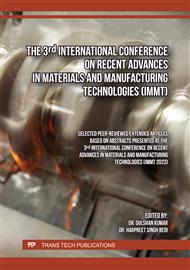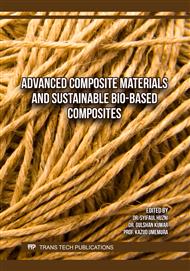[1]
Richardson MOW, Wisheart MJ. Review of low-velocity impact properties of composite materials. Composites Part A 1996;27:1123–31.
DOI: 10.1016/1359-835x(96)00074-7
Google Scholar
[2]
Abrate S. Impact on laminated composite materials. Appl Mech Rev 1991;44:155–90.
Google Scholar
[3]
H Kumar M, NR Mathivanan, Experimental investigation of Glass Laminate Aluminium Reinforced Epoxy characteristics influences through low velocity impact test, Adv. Mater. Process. Technol., 9 (2), 2023; 689-701
DOI: 10.1080/2374068x.2022.2096829
Google Scholar
[4]
NR Mathivanan, J Jerald, Experimental investigation of low-velocity impact characteristics of woven glass fiber epoxy matrix composite laminates of EP3 grade, Mater. Des., 31 (9), 4553-4560
DOI: 10.1016/j.matdes.2010.03.051
Google Scholar
[5]
Zhou J, Wen P, Wang S. Numerical investigation on the repeated low-velocity impact behavior of composite laminates. Compos B 2020;185:107771.
DOI: 10.1016/j.compositesb.2020.107771
Google Scholar
[6]
Chung DDL. Carbon Fiber Composites. Boston: Butterworth - Heinemann; 1994.
Google Scholar
[7]
Abrate S. Impact on Composites Structures. Cambridge: University Press; 1998.
Google Scholar
[8]
A.M. Amaro, P.N.B. Reis, MFSF. De Moura, M.A. Neto, Influence of multi-impacts on GFRP composites laminates, Compos. Part B Eng. 52 (2013) 93–99
DOI: 10.1016/j.compositesb.2013.03.041
Google Scholar
[9]
Mohammad Rezasefat, Amanda A.X. da Silva, Sandro C. Amico, Marco Giglio, Andrea Manes, Repeated impact behaviour of inter-ply hybrid aramid/S2-glass epoxy laminates, Thin-Wall Struct, 86. 2023; 110680
DOI: 10.1016/j.tws.2023.110680
Google Scholar
[10]
Yun Wan, Jian Yao, Hao Li, Yonghu Huang, Peiyu You, Yichen Xu, Zuxiang Lei, Experimental studies of low-velocity impact behavior on hybrid metal wire net/woven carbon-fiber reinforced composite laminates, Composites Communications, Volume 32, 2022, 101185, ISSN 2452-2139
DOI: 10.1016/j.coco.2022.101185
Google Scholar
[11]
Mohammad Rezasefat, A. Gonzalez-Jimenez, Dayou Ma, Alessandro Vescovini, Luca Lomazzi, Amanda A.X. da Silva, Sandro C. Amico, Andrea Manes, Experimental study on the low-velocity impact response of inter-ply S2-glass/aramid woven fabric hybrid laminates, Thin-Walled Structures, Volume 177, 2022, 109458, ISSN 0263-8231
DOI: 10.1016/j.tws.2022.109458
Google Scholar
[12]
B. Vieille, J.-D. Pujols-Gonzalez, C. Bouvet, T. Breteau, C. Gautrelet, Influence of impact velocity on impact behaviour of hybrid woven-fibers reinforced PEEK thermoplastic laminates, Composites Part C: Open Access, Volume 2, 2020, 100029, ISSN 2666-6820
DOI: 10.1016/j.jcomc.2020.100029
Google Scholar
[13]
Jinfeng Peng, Deng'an Cai, Yuan Qian, Chang Liu, Low-velocity impact and compression after impact behavior of 3D integrated woven spacer composites, Thin-Walled Structures, Volume 177, 2022, 109450, ISSN 0263-8231
DOI: 10.1016/j.tws.2022.109450
Google Scholar
[14]
Bulent Murat Icten, Binnur Goren Kıral, Mehmet Emin Deniz, Impactor diameter effect on low velocity impact response of woven glass epoxy composite plates, Composites Part B: Engineering, Volume 50, 2013, Pages 325-332, ISSN 1359-8368
DOI: 10.1016/j.compositesb.2013.02.024
Google Scholar
[15]
K. Azouaoui, N. Ouali, Y. Ouroua, A. Mesbah, T. Boukharouba, Damage characterisation of glass/polyester composite plates subjected to low-energy impact fatigue, Journal of Sound and Vibration, Volume 308, Issues 3–5, 2007, Pages 504-513, ISSN 0022-460X
DOI: 10.1016/j.jsv.2007.04.014
Google Scholar



